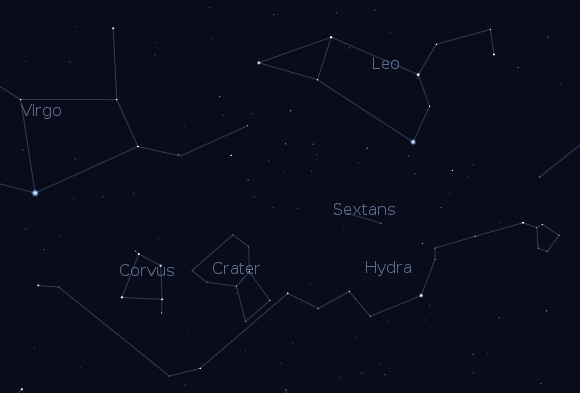¡SkyCaramba! Weekly astronomy blog for the week ending May 18, 2013
Some old stories say the crow used to be a beautiful bird. It had silvery white feathers and a lovely song. But it made the mistake of lying to a being with supernatural powers and has never been known as an enchanting creature since. This story is immortalized in our night sky.
The Greek legend tells of the day Apollo sent Corvus, his feathered and faithful servant, to fetch him some spring water in a bowl. Corvus left right away and should have returned from his mission fairly quickly. But the bird spotted a fig plant and decided to take a lunch break.
As he landed to feast upon the fig’s berries, Corvus saw they weren’t ripe yet. Thinking about the fruits were maturing into a delicious treat, the crow forgot about his water fetching assignment. He waited for the berries to ripen.
Figs don’t ripen quickly. Corvus may have waited a few weeks not thinking at all about his boss waiting for a drink of water. After finally gorging on the berries, he remembered what Apollo had sent him out for. Frantically, Corvus picked up the bowl, retrieved some water, and made up a story about a snake guarding the spring. To add credence to his story, Corvus picked up a snake to return with.
So imagine this bird carrying back to Apollo a bowl full of water and a snake at the same time. And despite his strength and dexterity, Corvus tells the god he couldn’t fetch the water quickly because the snake kept him from it. An enraged Apollo punished the crow for his tardiness and attempt at deceit.
In our sky, the snake is represented by Hydra. The snake has Crater, the water bowl on his back. Corvus is also on the snake’s back. But now Hydra is on a mission ordered by Apollo. He’s depriving the crow of any water.
The legend also says Apollo changed the crow as it is on Earth into an unattractive bird with a harsh squawk. Some say the bird’s voice is scratchy, as if it’s in desperate need of a drink.
Corvus, Crater, and Hydra are evening constellations this time of year. Look for them in the south and southwest after sunset if you’re in the northern hemisphere. From about 10° to 30° south, they’ll be on the line that goes overhead. And from points farther south, the constellations will be to the north and northwest.
¡SkyCaramba!
http://www.umich.edu/~lowbrows/guide/hydra.html
